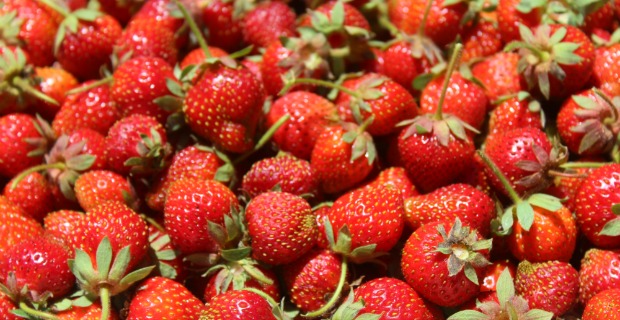The abundance of spring often shows it first blaze of glory in the form of perfectly ripe, richly red, amazingly sweet, little strawberry gems.
We wait rather impatiently for them as they shift from green to white to red and then eat as many as we can straight off the plant and still warm from the sun.
Once we’ve had our fill of straight-out-of-the-field goodness, we move to keeping a bowl full in the fridge and an abundance of heavy cream on hand to drench them in when our sweet tooth calls for something truly decadent.
However, despite our best efforts at eating every last one fresh, in an especially abundant season, there will always be a need to find the best ways to preserve strawberries rather quickly so they can be enjoyed again at a later date.
Of course, you could always bake them into pies, tarts, or muffins.
If you’re feeling adventurous, you might even try this strawberry cobbler with gluten-free corn masa topping! (This is definitely next on my baking list using some of our very own blue corn flour!)
And if you have the time and know-how, strawberry jam is always a crowd pleaser 🙂
However, if the days are short and the strawberries in your yard or from your local farmers are truly abundant, there’s no sense in letting a single one go to waste.
My two favorite (low cost) ways to preserve strawberries are to freeze them or dehydrate them and, as you’ll see below, are super simple ways to preserve the spring bounty in no time flat.
Preserve Strawberries by Freezing Them
Frozen strawberries (like all berries) are a wonderful addition to smoothies (where they act as tasty ice cubes) or any other recipe that doesn’t mind super juicy and a bit mushy berries.
Freezing your strawberries is also a convenient trick when you long for sparkling jars of jam but simply don’t have the time right this minute.
How to Freeze Your Strawberries
- Wash your berries in a colander under gently running cool water
- Lay your berries out to dry on a clean kitchen (or paper) towel
- De-stem and hull your berries (if planning to use in jams later) or don’t (the tops are edible and won’t matter if you’ll be using them in smoothies)
- Lay your berries out in a single layer on parchment or wax paper on a cookie sheet (this ensures they won’t stick together when freezing which will help you with measuring out your berries later)
- Place sheet in freezer for 24 hours
- Bag up your berries with the date frozen and place back into the freezer for later use
Preserve Strawberries by Dehydrating Them
A perfect snack for kiddos, dried strawberries can be eaten alone or added to your favorite trail mix or granola. If you have the willpower, you can save them for a special treat when the seasons shift when you can top your oatmeal or breakfast polenta with a bit of summer magic in the dead of winter.
How to Dehydrate Your Strawberries
- Wash your berries in a colander under gently running cool water
- Lay your berries out to dry on a clean kitchen (or paper) towel
- Hull your and slice your berries (it doesn’t matter which direction you cut your berries, you just want them all roughly the same thickness)
- Lay berry slices on your dehydrator trays in a single layer allowing a bit of space between each for proper air flow)
- Turn dehydrator on to 135* (or medium-low depending on your model) and allow to dry for 8-10 hours. You are aiming for uniformly dry slices, crisp rather than leathery.
Conditioning Your Dried Strawberries (via Missouri University Extension)
Even when a food tests dry, it may not be uniformly dry. Also, there is a chance of contamination of dried foods, especially if racks have been exposed to the open air for any time. Therefore, conditioning and pasteurizing should be done before storing.
Conditioning is the process used to equalize, or evenly distribute, moisture left in the food after drying. It is usually done to fruits, herbs and seeds to improve storage, because it decreases the chance of spoilage, especially by molds. To condition a food, follow these steps:
- Cool foods on trays
- Pour into a large, nonporous container of food-grade material; fill to about two-thirds full
- Cover container and place in a convenient, warm, dry place. Shake container daily or stir contents at least once a day for 10–14 days
- Check for condensation on the lid and any signs of spoilage. If condensation occurs, return food to the dryer to finish the product
- Recondition after it is dry
- Cool thoroughly before packaging
Freshly dried fruit can be added to the conditioning batch within the first five days. Conditioning time will need to be lengthened to accommodate the additional food.
Caution:
If any sign of mold growth occurs, destroy the product.
Enjoy!
Whether you eat them fresh or preserve them for later, there’s truly nothing like a local strawberry harvested at peak perfection! Enjoy every bite 🙂
xoxo,
M





